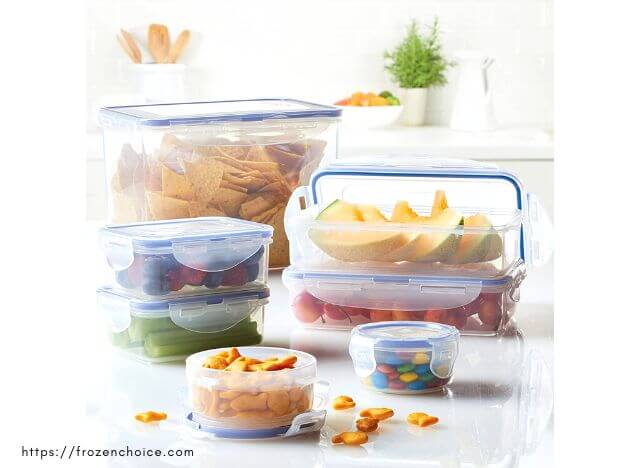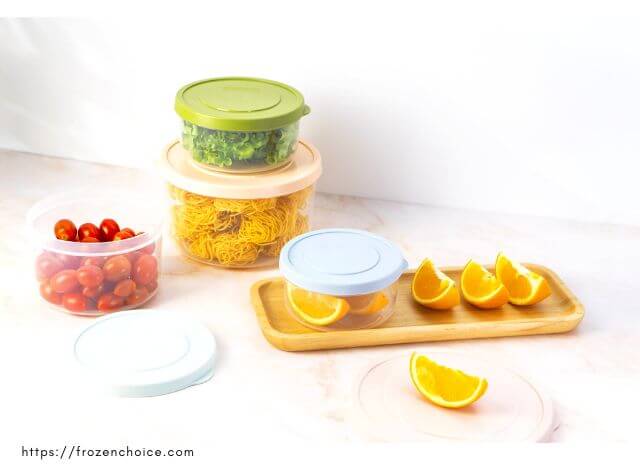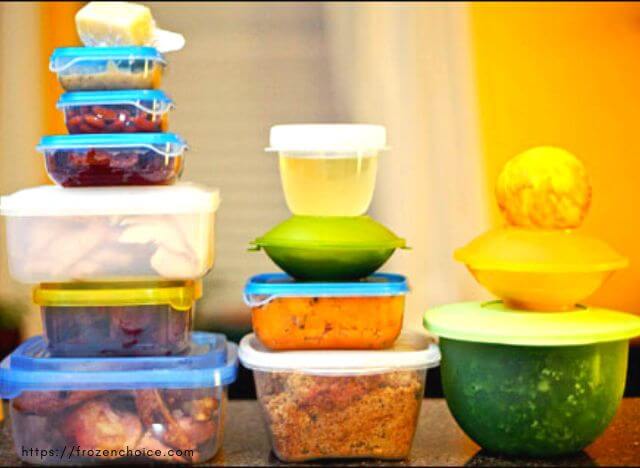Plastic seems to be everywhere. Plastic is found in children’s toys, food containers, cosmetic bottles, tubs, wraps, and lots of bags and bottles used for food and drink. Some types of plastic are environmentally friendly and safe for human, while others contain many toxic substances that are harmful to users. It’s undeniable that plastic containers are very light and convenient. However, is it safe to put hot food in plastic containers?
Advantages and disadvantages of plastic containers
Plastic food containers are chosen by many people to preserve food. The most obvious advantage is that they are quite durable, not afraid of being broken like other materials. The price of plastic boxes is quite cheap, many sizes for you to choose. In addition, because the plastic container is low in weight, it is easier when you want to carry food away.
Besides the above advantages, plastic food containers also has certain disadvantages. Plastic containers are often more difficult to clean than stainless steel or glass containers. At the same time, they are also susceptible to abrasion, or appear scratches that cause unsightly. In addition, plastic is also very susceptible to impact when encountering high temperatures. If you regularly store hot food, chemicals from plastic easily stick to food, enter the body and accumulate, affecting health.

Are plastic containers safe?
Scientists have discovered that certain chemicals in plastic can leak out of plastic and go into the food and drinks we eat.
Reheating food or storing hot food in a plastic container will leach chemicals into your food, putting you at greater health risks.
Some of these chemicals have been linked to health problems such as hormone disruption, metabolic disorders (including obesity) and reduced fertility.
Plastic is made of chemicals. The two main types of plastic chemicals that can cause harm to pregnant women and babies are:
- Bisphenol A (also known as BPA) makes plastic clearer and stronger. They are sometimes used as baby bottles, water bottles or metal cans.
- Phthalates make the plastic soft and supple. Medical items (such as tubes), shampoo bottles, food and makeup containers may contain this substance.
Exposure to these chemicals during pregnancy can cause brain and behavioral health problems in the unborn baby.
Therefore, it is better to check the plastic number of any plastic items before purchasing. Plastic is divided into 7 types, some are safe for food, others are not.
Further reading: Freezer Safe Plastic Containers
Is it safe to put hot food in plastic containers?
Many plastic cooking utensils or food containers contain harmful substances which can be released and leach into food when at high temperatures above 70°C. If ingested in high doses, these chemicals can trigger liver and thyroid disease. They also lead to infertility, cancer and high cholesterol.
Scientist have warned consumers against using plastic containers to hold hot food (above 70°C), because of the risk of absorbing a range of harmful chemicals. Even eating a small amount – 90 micrograms, is dangerous to the health of a person weighing 60 kg.
You should never keep hot food in plastic containers. Much evidence proves that plastics used in the food industry contain many harmful toxins that can get into food. When plastic is heated or poured with something hot, it can leach chemicals faster. So, putting hot food in plastic containers is not safe at all.
If plastic is the only thing you have, you should wait until your food is less than 120 degrees F before adding it to the plastic container.
When buy food from outside, you absolutely should not use plastic containers to keep hot food. It’s extremely unsafe when restaurants or convenience stores store hot food in plastic containers or heat food in plastic containers in the microwave.
Do not reheat or cook food in a plastic container, even if the plastic container is marked as microwave safe. Transfer food to a glass bowl whenever possible before reheating.
You may also like: How Long Can You Keep Frozen Food in the Freezer?
What plastics should you avoid?
BPA is a toxic substance and is often found in the plastic containers, so you should limit use them. If possible, avoid using them. Instead, you should use stainless-steel or glass containers to keep yourself safer, especially for young children.
Here are the plastics best avoided:
Plastic number 1
Plastic number 1 contains polyethylene terephthalate (PET, PETE or polyester), which is considered hazardous to the human body.
It is used for water bottles and soda bottles, cooking oil containers, plastic peanut butter jars and containers for other popular food items. However, it is made with a porous surface that helps trap bacteria.
This plastic can pose a significant threat to anyone’s health, whether human or pet. They disrupt the endocrine system, antimony contributes to cancer development, skin problems and fertility problems.
Plastic number 3
It contains a lot of phthalates. Number 3 is even considered more harmful than number 1 because it includes bisphenol A (BPA), lead, phthalates, mercury, dioxin, and cadmium.
They are sturdy, resilient and can be found in toys, containers, shampoo, squeeze bottles, oil bottles, shower curtains, …
Plastic number 6
Some of the number 6 products are food packaging and containers, egg cartons, disposable cutlery, CDs and DVDs, hangers, test tubes and smoke detectors. It can also damage the nervous system and cerebral cortex.
Several medical studies have shown that number 6 can damage the lungs, liver, genes and adversely affect the immune system.
Plastic number 7
This type is called the other (O), which refers to all other plastics that contain polycarbonate (PC).
Plastic with PC can leach bisphenol A (BPA), an endocrine disruptor, that affects a person’s estrogen hormone. It can cause cancer, affect sperm production in men and chromosomes in women, cause pubertal disorders, affects behavior, immunity, neurological function and heart health. This plastic is also responsible for miscarriages, diabetes, obesity and metabolic diseases.
Plastic number 7 can be found in products like water bottles and containers, baby bottles, ketchup, juice containers, eyeglasses, auto parts, and lab equipment.

What plastics are safer to use?
Plastic number 2
It contains high-density polyethylene (HDPE). Some of the products include juice and water bottles, medicine bottles, opaque milk cartons, and cereal boxes.
While it is generally considered safe when used in limited amounts. Studies have shown that number 2 plastic can leak nonylphenols, especially endocrine disruptors, when exposed to sunlight.
Plastic number 4
This plastic contains low density polyethylene (LDPE). It includes grocery bags, bread packs, film applications, frozen foods and garbage bags, beverage cups, squeeze bottles, and food containers.
It is relatively safer than other plastics, but it is still known to leach the endocrine disruptor nonylphenol, especially in sunlight.
Plastic number 5
This substance contains polypropylene (PP) in food containers, sanitary pads and some parts of household appliances and cars.
This type is safer and more stable but does not exclude the possibility of leaching plastic additives.
Further reading: The Best Kitchen Gadgets for Healthy Eating
How to avoid plastic, BPA and BPS
Although BPA is still found in box liners, receipt papers and many plastic products. I would recommend avoiding it altogether.
Following is how to reduce using plastic.
- Store your food in a reusable glass or stainless-steel container.
- Avoid aluminum soda cans.
- Avoid canned foods.
- Use a glass bakeware for all your baking needs.
- Avoid paper cups with plastic liner and carry a Reusable KeepCup or coffee cup.
- Make coffee with a glass French press or a favorite personal percolator.
- Not buying food packaged in plastic. You should make your own, it’s so much tastier anyway.
- Do not use plastic water bottles. Instead, choose glass or stainless-steel reusable bottles like Kleen Kanteen or Yeti.
How to safely use plastic food containers
It is almost impossible to have a plastic-free kitchen as plastic is everywhere. Precisely because you can’t avoid it, you should know how to use it safely.
Avoid heating the plastic
While polycarbonate plastic is strong and long-lasting, it can be damaged by high temperatures and overuse. Plastic containers for food packaging that can be used in the microwave should not be reused, they are safe for single use only. Reheating plastic in the microwave isn’t the smartest thing to do.
Don’t put plastic containers in the microwave because the heat may break them down over time and allow BPA to leach into foods.
Using plastic containers for hot food or washing them in the dishwasher can increase the chance of harmful chemicals leaking out of the can and into your food or liquids.
Avoid hot water
Washing anything with hot water will help get rid of germs, but plastic containers are different.It is not safe to clean plastic containers with hot water or to store hot water in plastic bottles. Hot water releases chemicals, which can harm the water in the bottle or the food in the plastic container.
Recycling plastic containers
Plastic will always take a long time to decompose. Recycling and reusing plastic materials and converting them into other products can save landfills. To reuse them, for example, you can use a bottle of laundry detergent as a watering can, make piggy bank from reusable plastic bottles or use lotion bottle into charging dock, ….
Further reading: What are the Best Food Storage Containers for Fridge?
How to clean plastic storage containers
Plastic food containers are often easier to stain and smell food than glass containers. Cleaning plastic containers is also more difficult and time consuming.
Pre-wash immediately after taking the food out of the plastic container.
You should wash the plastic container as soon as possible to remove food odors and residual stains. If you don’t have time, you should pre-rinse and soak the box with water. Then rinse thoroughly with warm water and dishwashing liquid. Finally, you rinse with clean water.
Wash with vinegar
After washing the plastic box with warm water and dishwashing liquid, fill the box with vinegar and soak it for 3 minutes. Pour the vinegar away and wash it with cold water and dishwashing liquid again. This way, all stains and odors will disappear.
Use fresh lemon
When storing foods with strong odors and flavors such as curry, Thai hot pot, etc., in plastic containers. The smell and color will easily stick to the box. You just need to rub the lemon on the side of the box and then soak it with warm water after taking out the food. Then, wash it with dishwashing liquid and the stain will be cleaned.
Use baking soda
Pour some warm water and some baking soda and rub the inside and around the box. Leave it on for a day and then wash it off. You do this until the box is completely clean of stains and odors.
Soak in warm water and dishwashing liquid
One method of cleaning stains on plastic food containers is to soak them in warm water with a little dishwashing liquid. Warm water will help deodorize and easily wash away stubborn stains on plastic containers.
Notes when cleaning the plastic container
Use only warm water, not hot water. Do not use abrasive pads or sponges to scrub hard because the surface of the plastic box can be scratched, reducing durability.
After cleaning, it is recommended to turn the plastic box upside down in the dish rack to let it dry quickly or dry it with a clean cloth to dry it before storing it to avoid moisture, creating an environment for bacteria to multiply and grow.
Food containers alternatives to plastic
It’s very difficult to completely eliminate plastic from our lives, but we can all reduce our use of plastic, especially in the storage and preservation of our food, which is how most people exposed to BPA. Here are five food preservation alternatives you can consider when saying goodbye to plastic.
Glass storage containers
Most sets come with a lid for convenience. These containers are easy to find, durable, and generally affordable. In addition, you can put them in the dishwasher without worrying about the material degrading over time.
Glass canning jars
Canning jars are very useful. They are used for many years to keep food fresh, safe and reusable. You can also store salads as they are also large in size.
Stainless steel
Stainless steel is the material for making pots and pans. If it’s good enough for cooking, it’s good enough for holding food. Transfer your leftovers from a stainless-steel saucepan or cooker to a stainless-steel container. Like the plastic box, stainless steel is so durable you can’t break it. In terms of aesthetics, they are great for decorating your kitchen.
However, stainless steel can oxidize, rust and leach into food if stored for a long time. Especially when encountering highly acidic foods such as sour substances, vinegar, lemon or fermented substances. Therefore, stainless steel is not recommended for storing liquids.
Silicone containers
These versatile food containers come in a variety of colors and sizes. Many varieties are also oven safe.
Cloth food sacks
These containers are great for bread and other dry snacks. You can do it yourself if you have basic sewing skills. However, you can easily buy them in many stores in case you don’t like sewing.
FAQs
What factors should I take into consideration when buying plastic containers?
Material
Glass, stainless teel or plastic, which one is your choice? The answer depends on the needs and budget. If you need to carry food away, do not store hot food, give preference to plastic containers that will be more economical.
In addition, you can use glass containers when you need to store food in a long time or keep the food that has just been cooked. Unlike plastic containers, glass containers are safe for hot food. At the same time, if you focus on aesthetics, then using a glass box is also a more suitable choice for you.
Stainless steel container is also a good choice. It is suitable for storing coffee, tea, sugar, flour, and other dry foods. It’s not recommended for liquids.
Capacity, size and style
Glass food containers on the market come in many different capacities, sizes and designs. If you buy a container for the purpose of storing soup for school or work, you can choose the one with 400-600ml capacity. If you choose a glass container for food to store in the refrigerator such as meat, fish fillet, etc., you should choose containers with a capacity of 700ml or more.
In terms of design, despite the same size and capacity, square and rectangular boxes will take up less space than round boxes. Therefore, when you need to store a large amount of food in the refrigerator, you should choose square and rectangular containers for easy arrangement and convenient removal.
Besides, if you want to preserve fruits and vegetables, rectangular boxes are the best choice for convenient storage. For liquids, juices, and smoothies, it is recommended to use round boxes, screw lids and link many boxes together.
Gadgets for storing food
Anti-spill rubber roller: When you store liquid foods such as soup, porridge, etc., you should choose containers with rubber seals inside the lid to prevent water or liquid from spilling out when moving. In addition, this seal will keep the food container airtight, retain the temperature of the food inside, and not worry about gas entering and damaging the food. Currently, many types of glass food containers and high-grade plastic containers are also equipped with this convenient lid, so you can use it if you like.
Box lid with lock: This is also a note when you want to choose to buy glass food containers or high-quality plastic containers. The lock helps the lid to be more tightly attached to the body of the box, limiting the spillage of food during transport and helping to seal the air, keeping the heat of the food inside.
Exhaust valve: You should look for the type of lunch box that has an evaporator valve on the lid so that when heating food in the microwave, the air in the box will escape, avoiding the pressure in the box being too high to cause swelling and explosion.
How to clean plastic without scratching
Avoid using abrasive cleaners that can scratch the plastic. Instead, you should use an all-purpose, non-abrasive cleaner, or a mixture of baking soda and water. Apply the cleaner to the surface or on a damp sponge and rub gently over the plastic container. Then, rinse or wipe the plastic containers.
How to get red stains out of plastic containers
In this case, you simply need to create a mixture of 1 teaspoon of water, 2 tablespoons of baking soda and 1/4 teaspoon of soap. Use an old toothbrush or other gentle scrubber to scrub the mixture into the plastic. Then, let it sit for about 15 minutes, scrub it again and rinse it off with clean water.
Final thoughts
The dangers of plastic food containers are real. However, it’s impossible to avoid all plastic containers and you shouldn’t obsess over every piece of plastic. You need to choose the safe containers for storing and limit using plastic to store food.
For hot food, it’s best to use glass containers. Besides, you can do smartly remove plastic in places that are easy to replace, not only food containers, but also dishes and baby bottles.

